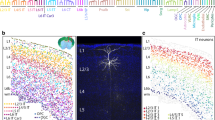Summary
As growth cones interact with targets, they become presynaptic terminals by losing growth cone characteristics and acquiring presynaptic characteristics. Results presented here show that transitional elements can be identified in cell cultures of rat cerebellum, which have some characteristics of both growth cones and presynaptic terminals. During the first week in culture, slender growth cones have fine filopodia. Subsequently, many growth cones in contact with the polylysine substrate spontaneously enlarge and become non-motile. In transitional elements, the synaptic vesicle protein p65 extends into the peripheral domain and in some cases, extends into filopodia. Many of these transitional elements have active filopodia but show no movement over the substrate for periods of up to nine days. These transitional elements have lost the actin-rich peripheral domain of the growth cone but retain actin labelling in the filopodia. With electron microscopy, transitional elements were seen to contain accumulations of synaptic vesicles at the site of contact with the substrate. Electron microscopic immunocytochemistry showed these synaptic vesicles labelled for p65 with silver-developed gold particles. Thus, transitional elements have characteristics of both growth cones and presynaptic terminals, suggesting that they may also have functional attributes of both growth cones and presynaptic elements.
Similar content being viewed by others
References
Argiro, V., Bunge, M. &Johnson, M. I. (1984) Correlation between growth form and movement and their dependence on neuronal age.Journal of Neuroscience 4, 3051–62.
Bovolenta, P. &Mason, C. (1987) Growth cone morphology varies with position in the developing mouse visual pathway from retina to first targets.Journal of Neuroscience 7, 1447–60.
Bray, D. &Chapman, K. (1985) Analysis of microspike movements on the neuronal growth cone.Journal of Neuroscience 5, 3204–13.
Bridgman, P. C. &Dailey, M. E. (1989) The organization of myosin and actin in rapid frozen nerve growth cones.Journal of Cell Biology 108, 95–109.
Buchanan, J., Sun, Y. -A. &Poo, M. -M. (1989) Studies of nerve-muscle interactions inXenopus cell culture: fine structure of early functional contacts.Journal of Neuroscience 9, 1540–54.
Burry, R. W. (1983) Antimitotic drugs that enhance neuronal survival in olfactory bulb cell cultures.Brain Research 261, 261–75.
Burry, R. W. &Hayes, D. M. (1989) Highly basic 30- and 32-Kilodalton proteins associated with synapse formation on polylysine-coated beads in enriched neuronal cell cultures.Journal of Neurochemistry 52, 551–60.
Burry, R. W., Ho, R. H. &Matthew, W. D. (1986) Presynaptic elements formed on polylysine-coated beads contain synaptic vesicle antigens.Journal of Neurocytology 15, 409–19.
Burry, R. W., Kniss, D. A. &Ho, R. H. (1985) Enhanced survival of apparent presynaptic elements on polylysinecoated beads by inhibition of non-neuronal cell proliferation.Brain Research 346, 42–50.
Burry, R. W., Lah, J. J. &Hayes, D. M. (1991) Immunocytochemical redistribution of GAP-43 during growth cone developmentin vitro.Journal of Neurocytology,20, 133–144.
Caudy, M. &Bentley, D. (1986) Pioneer growth cone steering along a series of neuronal and non-neuronal cues of different affinities.Journal of Neuroscience 6, 1781–95.
Forscher, P. &Smith, S. J. (1988) Actions of cytochalasins on the organization of actin filaments and microtubules in a neuronal growth cone.Journal of Cell Biology 107, 1505–16.
Goldberg, D. J. &Burmeister, D. W. (1986) Stages in axon formation: observations of growth ofAplysia axons in culture using video-enhanced contract-differential interference contrast microscopy.Journal of Cell Biology 103, 1921–31.
Henrikson, C. K. &Vaughn, J. E. (1974) Fine structural relationships between neurites and radial glial processes in developing mouse spinal cord.Journal of Neurocytology 3, 659–75.
Lah, J. J., Hayes, D. M. &Burry, R. W. (1990) A neutral pH silver development method for the visualization of 1-nanometer gold particles in preembedding electron microscopy.Journal of Histochemistry and Cytochemistry (in press).
Letourneau, P. C. (1983) Differences in the organization of actin in the growth cones compared with the neurites of cultured neurons from chick embryos.Journal of Cell Biology 97, 963–73.
Mason, C. A. (1985) Growing tips of embryonic cerebellar axonsin vivo.Journal of Neuroscience Research 13, 55–73.
Mason, C. A. &Gregory, E. (1984) Postnatal maturation of cerebellar mossy and climbing fibres: transient expression of dual features on single axons.Journal of Neuroscience 4, 1715–35.
Matthew, W. D., Tsavaler, L. &Reichardt, L. F. (1981) Identification of a synaptic vesicle-specific membrane protein with a wide distribution in neuronal and neurosecretory tissue.Journal of Cell Biology 91, 257–69.
Nakai, J. &Kawasaki, Y. (1959) Studies on the mechanism determining the course of nerve fibres in tissue culture I. The reaction of the growth cone to various obstructions.Zeitschrift für Zellforschung 51, 108–22.
Nordlander, R. H. &Singer, M. (1982) Morphology and position of growth cones in the developingXenopus spinal cord.Developmental Brain Research 4, 181–93.
Raisman, G. (1969) Neuronal plasticity in the septal nuclei of the adult rat.Brain Research 14, 25–48.
Rees, R. P., Bunge, M. B. &Bunge, R. P. (1976) Morphological changes in the neuritic growth cone and target neuron during synaptic junction development in culture.Journal of Cell Biology 86, 240–63.
Robbins, N. &Polak, J. (1988) Filopodia, lamellipodia and retractions at mouse neuromuscular junctions.Journal of Neurocytology 17, 545–61.
Tosney, K. W. &Landmesser, L. T. (1985) Growth cone morphology and trajectory in the lumbosacral region of the chick embryo.Journal of Neuroscience 5, 2345–58.
Skene, J. H. P. (1989) Axonal growth-associated proteins.Annual Reviews of Neuroscience 12, 127–56.
Vaughn, J. E. &Sims, T. J. (1978) Axonal growth cones and developing axonal collaterals form synaptic junctions in embryonic mouse spinal cord.Journal of Neurocytology 7, 337–63.
Author information
Authors and Affiliations
Rights and permissions
About this article
Cite this article
Burry, R.W. Transitional elements with characteristics of both growth cones and presynaptic terminals observed in cell cultures of cerebellar neurons. J Neurocytol 20, 124–132 (1991). https://doi.org/10.1007/BF01279616
Received:
Revised:
Accepted:
Issue Date:
DOI: https://doi.org/10.1007/BF01279616




